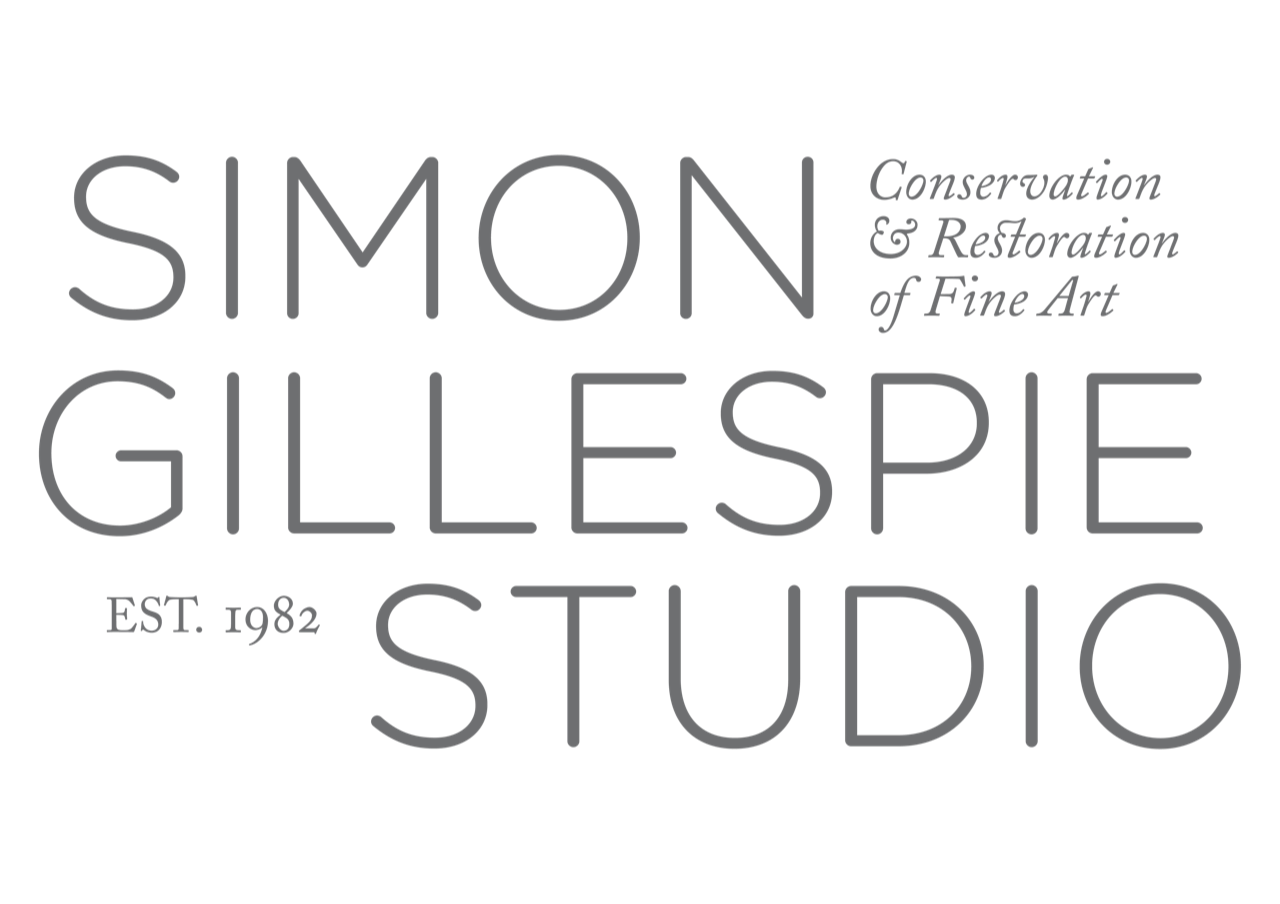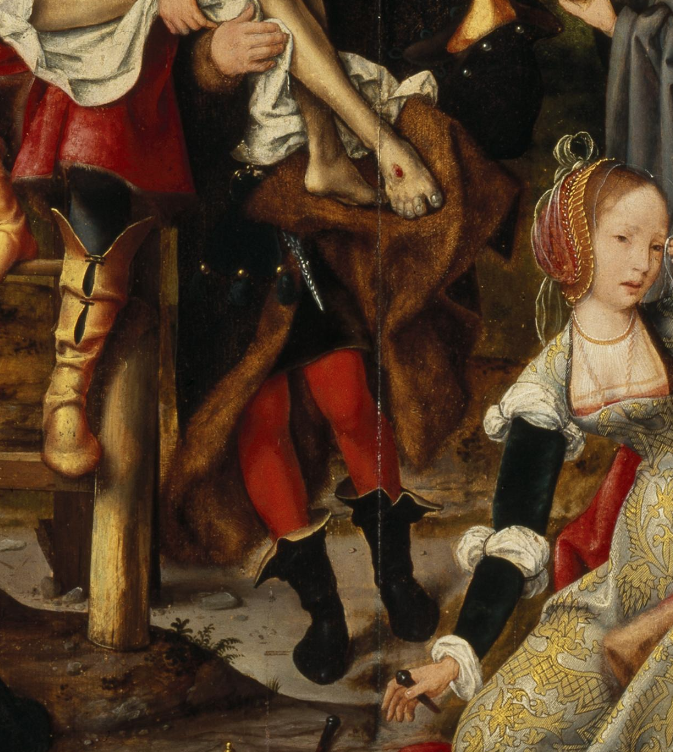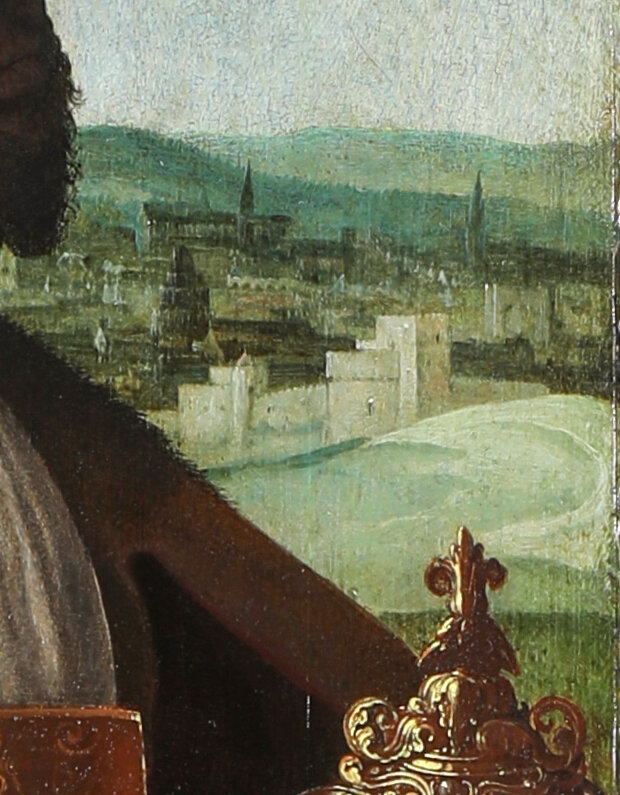‘Balthazar’ by Joos van Cleve
Before treatment
After treatment
This artwork on panel belongs to the collection of Brighton and Hove Museums and records attribute it to Bernaert van Orley. When Bendor spotted it on the Art UK website he thought it could be by Joos van Cleve, a Flemish painter active in Antwerp in the 16th century. Looking through the museum’s records, Bendor saw that over the years many different attributions had been suggested for the artwork by different art historians, and in 1954 someone had suggested that the Bernard van Orley attribution be changed to Bernard van Cleve. The painting depicts a character well known from traditional tellings of the Nativity: the man shown is Balthazar, one of the three kings who visited baby Jesus just after his birth in Bethlehem. In theological tradition, Balthazar is depicted as an African king to represent the theological message that Jesus was born to save the whole world. Art historically, this has meant that paintings of the Nativity scene are one of the few subjects where artists in Western art history have painted a black person.
Micha Leeflang, an art historian who has studied Joos van Cleve’s work for two decades, shared some fascinating insights with us about van Cleve’s characteristics. One notable aspect is that he painted his sitters looking kind and sympathetic. Compare his portrait of Henri VIII to the one painted by Holbein, it is quite a striking difference how much softer and less stern his expression is! In terms of his technique, van Cleve’s underdrawing style is one to look out for, with lots of hatching lines, and often he would write letters in certain places to indicate the colour to be used (almost like paint by numbers), with B for Blue and R for Red, which may have been useful to see early on in the process how many pigments would be needed and therefore to plan his budget for the more expensive pigments.
Henry VIII by Joos van Cleve (image from the Royal Collection Trust)
Henry VIII, detail of a copy after the lost original by Hans Holbein the Younger
When the painting arrived at the Studio, Simon immediately noticed a serpentine shape of the top, suggesting that the work was once the wing of a triptych altarpiece. Balthazar would have been on a side wing, facing the middle of the scene. At some point in the history of the artwork, the panel depicting Balthazar had been separated from the rest of the triptych and an insert had been added to the top of the shaped panel to make it rectangular. The insert is especially visible in raking light.
Detail of the painting before treatment in raking light, showing the original shaped top of the painting and later addition to the right hand corner.
The treatment was carried out at Simon Gillespie Studio by Simon Gillespie and Majo Prieto-Pedregal, both conservators accredited by the Institute of Conservation.
The painting was examined extensively under the microscope. In various areas, the original paint appeared abraded and there was later paint added on top. There was an old discoloured varnish too, and under the microscope darker particles of pigment could be seen in the varnish layer, making it even darker.
The panel was examined using infrared spectroscopy. Inspection of the IR images revealed the presence of underdrawing and the extent of losses to the original paint layers and the most recent overpaint. In particular, damage was identified in the face and other areas of dark/brown colours, indicating the sensitivity of the pigments used on those elements of the composition. Examination with the naked eye had revealed that some underdrawing lines were visible in the composition, and in the IR images more underdrawing lines could be seen that were not visible to the naked eye due to the opacity of the paint. Following a usual technique at the time, the drawings indicated with soft streaked lines the elements of shading to be painted, for example on the left sleeve of the velvet coat, the shirt, the legs and the ground at the bottom of the composition. There were also straight lines sketching the edges of the sceptre, golden cup and sword. The IR image also showed evidence of pentimenti, where the artist had changed the composition during the process of painting: for example the artist had originally placed Balthazar’s sceptre lower on his shoulder, the feather on his hat had also been moved, and a shoulder strap across the figure’s chest had been removed. The short skirt was initially drawn as a sort of roman military belt made up of leather strips, called cingulum militare, which the artist had changed to the pleated design we see today.
IR image of the whole panel
Detail of the IR image: look closely at the hatching on the leg, and the drawing lines of the leather strips of the original skirt design
Detail of the IR image, revealing the abraded paint on the face, changes to the position of the sceptre, and hatching on the shirt
Detail of the IR image, showing drawing lines on the hand and also the sleeve
Tests were initially carried out to assess the best method to carry out a surface cleaning of the panel, to remove surface dirt and dust. This process was relatively simple and already made a difference to the brightness and visibility of the composition. After that, further testing was carried out to find a safe method to remove the old varnish and overpaint. A test was carried out in the area of the sky which revealed a lovely blue appearing from under the old discoloured varnish. Simon said '‘No matter how many times I’ve done this, it always gives me great pleasure, this moment. It’s so surprising’.
A screenshot from the BBC’s trailer for the programme, showing the beginning of the removal of the varnish from the area of the sky
As the cleaning progressed, we saw first hand that the painting had suffered from past harsh cleaning methods, with the face in particular having been abraded. Some of the process of removing the old varnish and overpaint was carried out under the microscope.
With the original paint layer no longer concealed by overpaint and retouching, similarities with Joos van Cleve’s work became even more apparent. For example, Bendor saw that an altarpiece by van Cleve depicting the Deposition of Christ included a figure whose knees are painted in a very similar manner to the knees of Balthazar, and even wearing similar red stockings! It appears that the two compositions also share other details, for example the two cities in the background each have an identical rotunda and castellated wall, and throughout the composition very similar underdrawing was visible through the thinning paint. All very promising for ‘our’ picture!
The Deposition of Christ by Joos van Cleve. Note the shaped tops of the wings of this triptych.
Detail of the Deposition looking at the distinctive knees of one of the figures
The Balthazar panel is made up of two planks, and the join between the two planks had split in the past and been repaired. During this repair, paint was applied over the join, extending over areas of original paint. This was confirmed in IR images. There was a cradle on the back (a supporting structure added to the panel), this was in good condition and was providing adequate support for the painting; it needed only a slight loosening of the horizontal components of the cradle.
Once the old varnish and overpaint had been removed, precise retouching was carried out to the old areas of loss in order to reintegrate them into the composition. Like the cleaning process, this was also a slow process requiring careful consideration and huge patience. A final thin layer of semi-matte protective varnish was applied and the painting was placed back into its frame.
After many weeks of treatment, the painting was ready to be shown to Micha Leeflang, the expert on Joos van Cleve. Micha immediately said that Joos van Cleve was the one who had painted it, and was extremely enthusiastic about the discovery. In particular, she noted that the drawn outline for the hands, the hatchings for the clothing, and the typical sketchy underdrawing combined with the finessed painting technique were all characteristic of Joos van Cleve’s techniques. She added: ‘the face is so good, so delicate and typical of Joos van Cleve’.
Simon and Bendor with expert Micha Leeflang
The painting is now back at Brighton and Hove museum, where it can be proudly displayed as a work by Joos van Cleve, painted in about 1520.
Balthazar’s face before treatment
Balthazar’s face after treatment
Detail of the costume before treatment
Detail of the costume after treatment
Detail of the city in the background before treatment
Detail of the city in the background after treatment
Detail of the feet and ground before treatment
Detail of the feet and ground after treatment
‘The transformation is a testament to all the work Simon and his studio have done’, Bendor said after the treatment was finished.
A depiction of the Nativity scene by Joos van Cleve now in the Detroit Institute of Art Museum, with Balthazar in the right-hand wing
The Balthazar panel was originally part of an altarpiece, the other pieces of which have not been identified. However, the Detroit Institute of Art has another triptych altarpiece by Joos van Cleve which can illustrate what our panel would originally have looked like within a bigger composition. See it here.
This other depiction of Balthazar also sheds light on an interesting aspect of our picture: the gloves worn by Balthazar. When Bendor first saw the Brighton panel in photos on the Art UK website, he was puzzled that it looked like Balthazar’s hands were painted a different colour to his face. Once the painting was cleaned and on closer inspection of the painting and the underdrawing lines (in particular the lack of drawing lines of nails in the underdrawing), it became clear that Balthazar is wearing pale red gloves with an oversized cuff that hangs in loose draping folds, in a similar design to the gloves Balthazar wears in this painting by Joos van Cleve (though the Brighton picture does not have the tassels).
Side by side comparison of the gloves in the Brighton picture (left) and Detroit picture (right)
This picture was treated for Brighton and Hove Museums as part of the BBC Four programme ‘Britain’s Lost Masterpieces’, for the 1st episode of the 5th series. A second painting was also treated for that episode, read about it here.






























